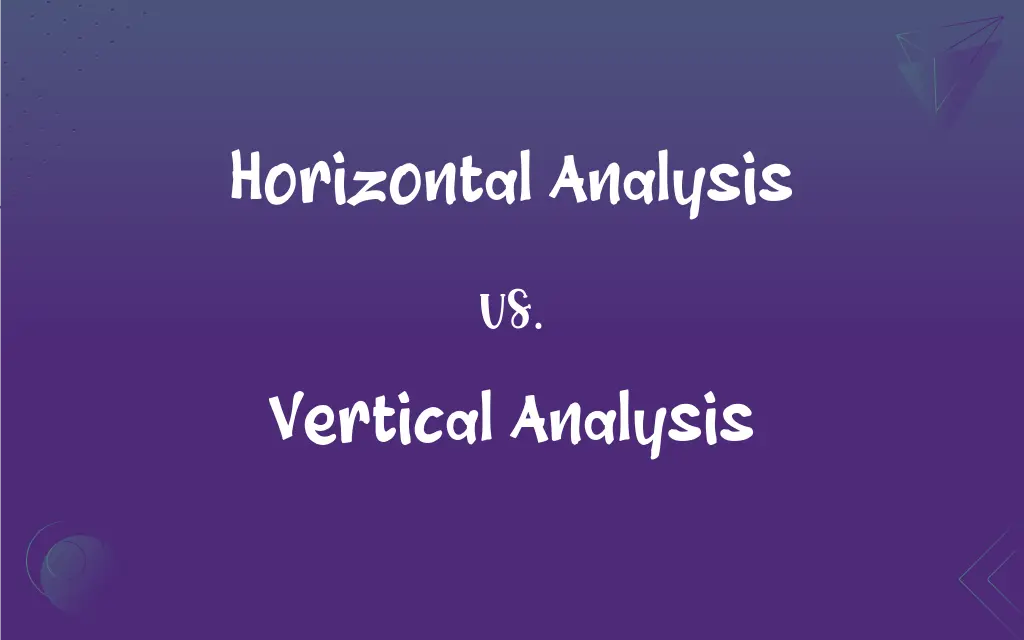Horizontal Analysis vs. Vertical Analysis: What's the Difference?
Edited by Aimie Carlson || By Janet White || Published on November 10, 2023
Horizontal Analysis compares financial data over multiple periods, while Vertical Analysis evaluates each item as a percentage of a base figure within the same period.

Key Differences
Horizontal Analysis and Vertical Analysis are tools used in financial analysis to understand and interpret financial statements. Horizontal Analysis examines changes in items on a financial statement over multiple periods. This approach helps analysts identify trends and patterns over time. In contrast, Vertical Analysis expresses every item on a financial statement as a percentage of a base number within a single period, such as total sales or total assets.
In Horizontal Analysis, an analyst might look at how revenue or profit margins have changed from one year to the next. If revenue increased by 10% from Year 1 to Year 2, this growth would be identified through Horizontal Analysis. Meanwhile, in Vertical Analysis, an analyst might determine what percentage of total revenue is constituted by a specific expense in a given year. If rent expenses represent 5% of total revenue, this would be derived through Vertical Analysis.
The primary purpose of Horizontal Analysis is to identify and quantify trends and fluctuations over time, allowing for comparisons across different periods. It often aids in forecasting future performance based on past data. On the other hand, Vertical Analysis is about understanding the proportional relationships between individual components and a whole within a single period. It's particularly useful for assessing the structure of an organization's income statement or balance sheet in a given timeframe.
When performing Horizontal Analysis, an analyst would often use absolute changes or percentage changes to compare figures over time. This can help determine if a company's financial health is improving, stagnant, or deteriorating. For Vertical Analysis, the primary technique involves calculating the ratio of each item to a total, which helps understand the composition and significance of individual components.
Both Horizontal Analysis and Vertical Analysis serve as complementary tools in financial analysis. While Horizontal Analysis offers insights into changes over time, Vertical Analysis provides a snapshot of a firm's financial structure during a specific period. Together, they present a comprehensive view of a company's financial health.
ADVERTISEMENT
Comparison Chart
Focus
Changes over multiple periods
Proportional analysis within a single period
Application
Identifying trends and patterns over time
Understanding financial structure of a specific period
Technique
Absolute or percentage changes
Expressing items as a percentage of a base figure
Purpose
Analyzing growth, decline, or stability
Assessing the relative weight of financial statement items
Snapshot vs. Trend
Provides a trend over time
Offers a snapshot of a specific period
ADVERTISEMENT
Horizontal Analysis and Vertical Analysis Definitions
Horizontal Analysis
Analysis of financial trends over time.
Horizontal Analysis revealed the declining profitability of the firm over the last three years.
Vertical Analysis
Expressing financial items as a percentage of a base figure within a period.
Vertical Analysis showed that administrative expenses were 10% of the total revenue.
Horizontal Analysis
Review of financial data to determine patterns over successive periods.
A detailed Horizontal Analysis showcased the impact of the marketing campaigns on yearly profits.
Vertical Analysis
Analyzing relationships between financial statement items within a single period.
Through Vertical Analysis, the company realized cost of goods sold represented 60% of sales.
Horizontal Analysis
Evaluating how specific financial items change across different intervals.
Their Horizontal Analysis of quarterly sales showed seasonality in their business.
Vertical Analysis
Proportional examination of financial data in a given timeframe.
Vertical Analysis of the income statement highlighted the significant role of licensing revenue.
Horizontal Analysis
Comparing financial figures across multiple periods.
Through Horizontal Analysis, the company noticed a steady 5% annual growth in revenue.
Vertical Analysis
Understanding the composition of financial statements at a specific point in time.
The firm's Vertical Analysis of its assets revealed a heavy dependence on long-term investments
Horizontal Analysis
Time-based assessment of financial statement elements.
Horizontal Analysis of the last decade's balance sheets indicated a growing reliance on external debt.
Vertical Analysis
Determining the significance of individual items relative to a total in a particular period.
Vertical Analysis indicated that R&D expenses made up 15% of the company's total expenditures.
FAQs
How does Vertical Analysis differ from Horizontal Analysis?
Vertical Analysis evaluates financial data as a percentage of a base figure within one period, while Horizontal Analysis looks at changes across periods.
Can Horizontal Analysis identify seasonality in revenues?
Yes, Horizontal Analysis can highlight patterns like seasonality by comparing data across periods.
Why is Vertical Analysis useful for investors?
Vertical Analysis provides insights into how each item relates to the total, helping investors assess financial structure.
What's the primary focus of Horizontal Analysis?
Horizontal Analysis focuses on comparing financial data over multiple time periods.
How can a company identify long-term trends using Horizontal Analysis?
By comparing financial data over several years, Horizontal Analysis can pinpoint long-term trends.
Can Horizontal Analysis help in predicting future performance?
Yes, Horizontal Analysis can aid in forecasting by identifying and analyzing past trends.
What is a common base figure in Vertical Analysis of income statements?
Total revenue or sales is a frequent base figure in Vertical Analysis of income statements.
What tools are essential for performing Horizontal Analysis?
Spreadsheets or financial software can facilitate comparisons across multiple periods in Horizontal Analysis.
For what purpose is Vertical Analysis mainly used?
Vertical Analysis helps understand the structure and composition of financial statements in a specific period.
Does Vertical Analysis look at absolute numbers or percentages?
Vertical Analysis focuses on percentages, expressing items relative to a base figure.
Is Horizontal Analysis relevant for short-term evaluations?
While it can be used for short intervals, Horizontal Analysis is especially valuable for long-term trend identification.
Can Vertical Analysis be used to compare two companies?
While it's primarily for internal assessment, Vertical Analysis can help compare financial structures of different firms when combined with other tools.
Can Horizontal Analysis detect anomalies in financial data?
Yes, by highlighting unusual fluctuations across periods, it can identify anomalies.
How can Horizontal Analysis be used in benchmarking?
Horizontal Analysis can track changes in key metrics over time, aiding in benchmarking against industry standards.
How do Horizontal Analysis and Vertical Analysis complement each other?
While Horizontal Analysis offers insights into changes over time, Vertical Analysis provides a snapshot of a specific period, together giving a rounded view of financial health.
What financial statements can be examined using Vertical Analysis?
Vertical Analysis can be applied to income statements, balance sheets, and even cash flow statements.
Does Horizontal Analysis consider external factors impacting financial data?
While it identifies trends in data, external factors' analysis requires additional contextual research.
In Vertical Analysis, can the base figure be different for different items?
Typically, one base figure is used for consistency, but different bases can be employed for specific analyses.
Why might a company prefer Vertical Analysis for internal reviews?
Vertical Analysis can offer insights into the internal structure and composition of financial data for a specific period.
How does Vertical Analysis treat non-recurring items?
They're still expressed as a percentage of the base figure, but analysts should consider their one-time nature.
About Author
Written by
Janet WhiteJanet White has been an esteemed writer and blogger for Difference Wiki. Holding a Master's degree in Science and Medical Journalism from the prestigious Boston University, she has consistently demonstrated her expertise and passion for her field. When she's not immersed in her work, Janet relishes her time exercising, delving into a good book, and cherishing moments with friends and family.
Edited by
Aimie CarlsonAimie Carlson, holding a master's degree in English literature, is a fervent English language enthusiast. She lends her writing talents to Difference Wiki, a prominent website that specializes in comparisons, offering readers insightful analyses that both captivate and inform.







































































